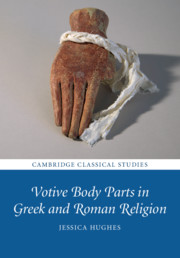Refine search
Actions for selected content:
23989 results in Ancient history
Bibliographical Essay
-
- Book:
- Science Writing in Greco-Roman Antiquity
- Published online:
- 20 April 2017
- Print publication:
- 03 April 2017, pp 149-156
-
- Chapter
- Export citation
4 - Commentary
-
- Book:
- Science Writing in Greco-Roman Antiquity
- Published online:
- 20 April 2017
- Print publication:
- 03 April 2017, pp 86-110
-
- Chapter
- Export citation
Appendices
-
- Book:
- Science Writing in Greco-Roman Antiquity
- Published online:
- 20 April 2017
- Print publication:
- 03 April 2017, pp 135-148
-
- Chapter
- Export citation
5 - Biography
-
- Book:
- Science Writing in Greco-Roman Antiquity
- Published online:
- 20 April 2017
- Print publication:
- 03 April 2017, pp 111-129
-
- Chapter
- Export citation
Appendix B - Eratosthenes’ Letter to King Ptolemy
-
- Book:
- Science Writing in Greco-Roman Antiquity
- Published online:
- 20 April 2017
- Print publication:
- 03 April 2017, pp 144-148
-
- Chapter
- Export citation
Spelling and Abbreviations
-
- Book:
- Science Writing in Greco-Roman Antiquity
- Published online:
- 20 April 2017
- Print publication:
- 03 April 2017, pp xv-xvi
-
- Chapter
- Export citation
3 - Encyclopaedia
-
- Book:
- Science Writing in Greco-Roman Antiquity
- Published online:
- 20 April 2017
- Print publication:
- 03 April 2017, pp 72-85
-
- Chapter
- Export citation
Index
-
- Book:
- Science Writing in Greco-Roman Antiquity
- Published online:
- 20 April 2017
- Print publication:
- 03 April 2017, pp 181-193
-
- Chapter
- Export citation
Appendix A - Arithmetical Epigrams from Book 14 of The Greek Anthology
-
- Book:
- Science Writing in Greco-Roman Antiquity
- Published online:
- 20 April 2017
- Print publication:
- 03 April 2017, pp 135-143
-
- Chapter
- Export citation
Contents
-
- Book:
- Science Writing in Greco-Roman Antiquity
- Published online:
- 20 April 2017
- Print publication:
- 03 April 2017, pp vii-vii
-
- Chapter
- Export citation
References
-
- Book:
- Science Writing in Greco-Roman Antiquity
- Published online:
- 20 April 2017
- Print publication:
- 03 April 2017, pp 157-180
-
- Chapter
- Export citation

Votive Body Parts in Greek and Roman Religion
-
- Published online:
- 31 March 2017
- Print publication:
- 06 April 2017
Chapter 3 - The Desire of a God
-
- Book:
- The Politics of Sacrifice in Early Greek Myth and Poetry
- Published online:
- 13 April 2017
- Print publication:
- 30 March 2017, pp 90-118
-
- Chapter
- Export citation
Acknowledgements
-
- Book:
- The Politics of Sacrifice in Early Greek Myth and Poetry
- Published online:
- 13 April 2017
- Print publication:
- 30 March 2017, pp viii-ix
-
- Chapter
- Export citation
Note on Abbreviations
-
- Book:
- The Politics of Sacrifice in Early Greek Myth and Poetry
- Published online:
- 13 April 2017
- Print publication:
- 30 March 2017, pp x-x
-
- Chapter
- Export citation
Conclusion
-
- Book:
- The Politics of Sacrifice in Early Greek Myth and Poetry
- Published online:
- 13 April 2017
- Print publication:
- 30 March 2017, pp 156-172
-
- Chapter
- Export citation
Index Locorum
-
- Book:
- The Politics of Sacrifice in Early Greek Myth and Poetry
- Published online:
- 13 April 2017
- Print publication:
- 30 March 2017, pp 193-196
-
- Chapter
- Export citation
Contents
-
- Book:
- The Politics of Sacrifice in Early Greek Myth and Poetry
- Published online:
- 13 April 2017
- Print publication:
- 30 March 2017, pp v-vi
-
- Chapter
- Export citation
Chapter 1 - Anger and Honorary Shares
-
- Book:
- The Politics of Sacrifice in Early Greek Myth and Poetry
- Published online:
- 13 April 2017
- Print publication:
- 30 March 2017, pp 27-54
-
- Chapter
- Export citation
Chapter 4 - Cities where Men Sacrifice
-
- Book:
- The Politics of Sacrifice in Early Greek Myth and Poetry
- Published online:
- 13 April 2017
- Print publication:
- 30 March 2017, pp 119-155
-
- Chapter
- Export citation
